We joined Babes Ride Out at their first edition of Babes Ride Supermoto last November and it was SO MUCH FUN. OMG YOU SHOULD SIGN UP FOR IT RIGHT NOW.
But I guess first things first…what is supermoto? Supermoto is basically a race on a tight track, on dirt bikes with street tires. The track runs on pavement and dirt, and it is a great way to behave totally irresponsibly on a motorcycle in a super responsible environment.
Socal Supermoto hosts several supermoto classes a month designed for all experience levels (and there are a few women-only days coming up!). They do, however, recommend you know how to ride a motorcycle as it is not an intro-to-riding class. The course fee includes track time, instruction, bike rental, gear rental, and a t-shirt at the end. In a given class, you may find that half the students are there for the first time, while the second half has been there multiple times.
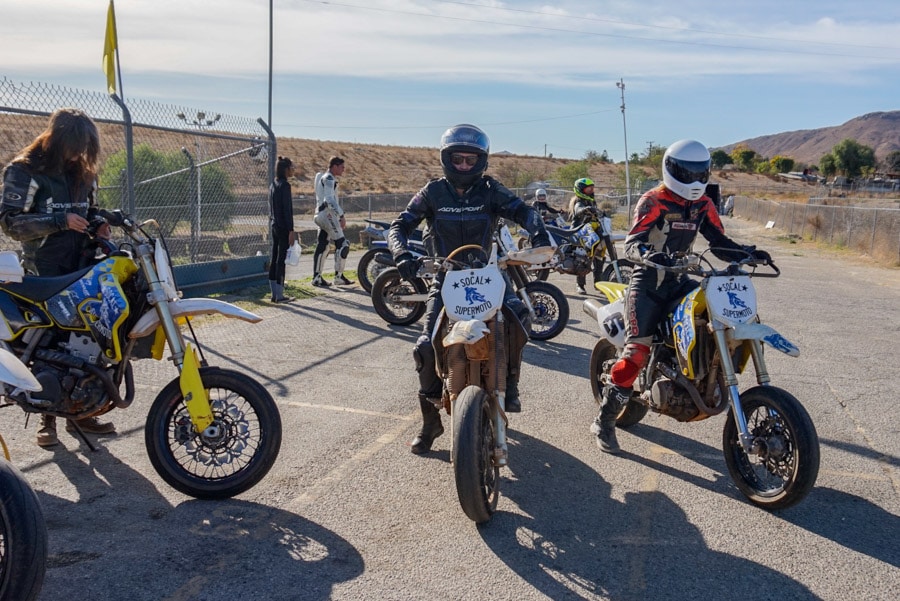
When you get to the Adams Motorsport Park in Riverside, the first thing you’ll do is sign your waivers and then head out to the gear trailer to find a set of leathers (unless you brought your own). There are also a few boots and helmets and gloves, but I’d recommending bringing your own of each of those pieces since the selection was more limited. I was surprised to note the abundance of average-person sized leathers. In a class of all women – no one was wearing a leather suit that was outrageously far off in sizing.
This was my first time attending a riding class since my MSF course in 2012 – which was maybe three girls and 20 military men. I loved being able to do this kind of a class in an all female environment. Brian (the instructor and president of Socal Supermoto) started getting into the ways people hurt themselves and others on the track, and I found that a lot of it didn’t apply since as women we aren’t socialized to … behave boastfully as much as most men in America are.
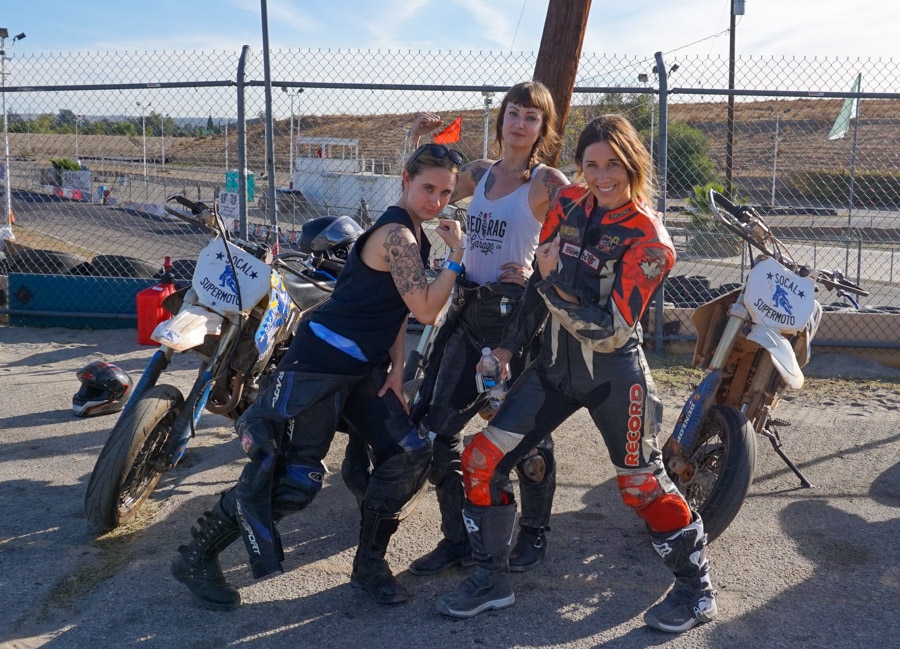
There are two types of bikes – DRZ-400s and TTR-125s. A lot of ladies gravitated toward the smaller bikes first – while others went right for the big boys. I think that might mostly be related to seat-height; the DRZ is a tall bike and it was a stretch for me to get a foot down (I’m about 5’5”) – which means it would be a risk for some of the shorter women in the class. I tried out a run on on the little bike – but ended up preferring the ground clearance, comfort, and extra oomph of the DRZ. But that little bike was pretty fun to rip around the track like a complete maniac!
The class is made up of two parts – classroom instruction and track time. Brian starts you out with two simple pieces of homework for the first track time: Ride around, don’t crash. For the first half of the day, the course is on the pavement portion of the track only and if you crash you’re done until after lunch. As long as you’re riding within your limits and start out slowly, you shouldn’t have any problems with the no-pavement crashing rule. And if you do get a little wild, you get to come back after lunch for the dirt part anyway. (I DID tip a bike over getting onto it because it was a teensy bit taller than the others – but that doesn’t count. If you’re on the shorter side and trying to ride a big bike, don’t be too worried about ending your day early misjudging your own height.)
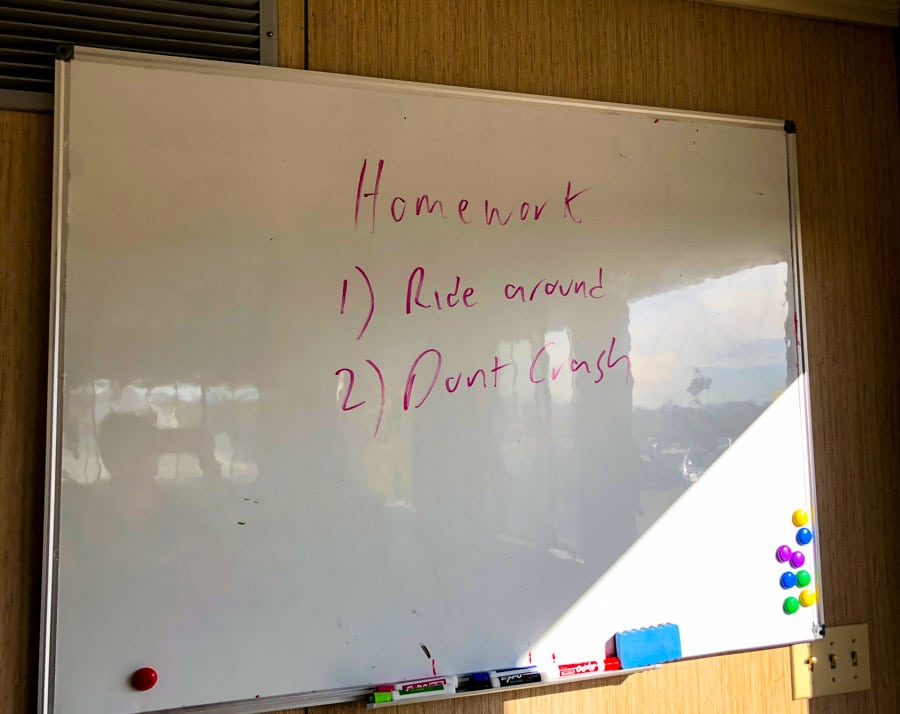
With each classroom session – Brian will give you a new thing to think about and work on in your next track session. This will include things like following proper lines, proper body positioning, and trail-braking (that’s when you use brake and throttle at the same time). With each track session, fellow trainer (and VERY FAST WOMAN) Kerryann hits the road with you – indicating when riders should follow her lines or body position while you’re on the bike.
Proper Lines
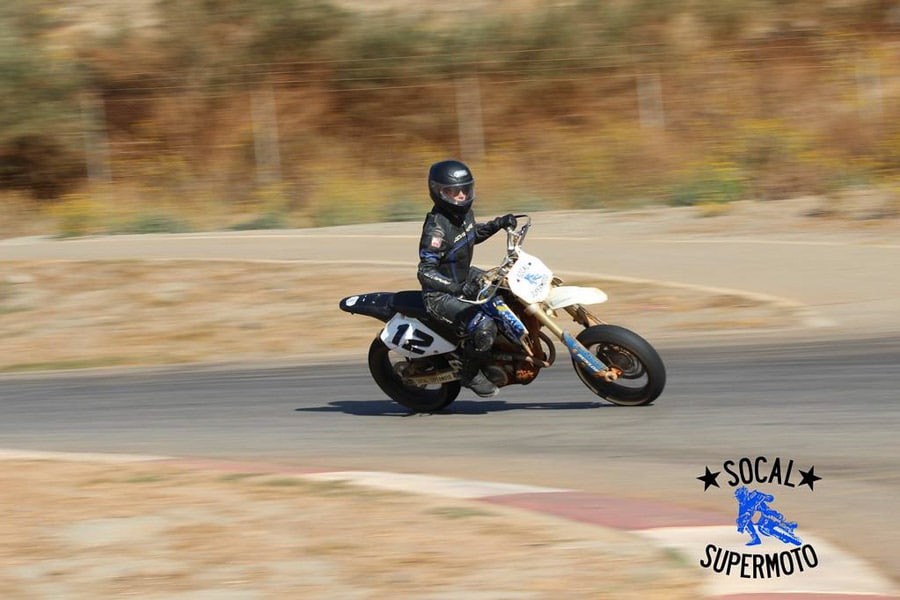 I ride … almost exclusively I guess … on the street. So when Brian started talking about turn-in points I had no idea what he was talking about. Sure, I know about apexes and basic cornering stuff, but since I haven’t ever ridden on a track it had never occured to me that there will always be an ideal point to start and end your turn on a predictable course. As a street rider, I usually just … turn when it feels right I guess? I kept finding myself turning some distance from the marked out recommended turn points on the track – turning when it “feels right” is a hard habit to break! I also found myself abandoning the preferred lines because there were other riders doing the same thing. By being a little more aggressive on the throttle on the end of my turn, I was able to pass those who were focusing on the lines and not speed in those corners.
I ride … almost exclusively I guess … on the street. So when Brian started talking about turn-in points I had no idea what he was talking about. Sure, I know about apexes and basic cornering stuff, but since I haven’t ever ridden on a track it had never occured to me that there will always be an ideal point to start and end your turn on a predictable course. As a street rider, I usually just … turn when it feels right I guess? I kept finding myself turning some distance from the marked out recommended turn points on the track – turning when it “feels right” is a hard habit to break! I also found myself abandoning the preferred lines because there were other riders doing the same thing. By being a little more aggressive on the throttle on the end of my turn, I was able to pass those who were focusing on the lines and not speed in those corners.
Body Positioning
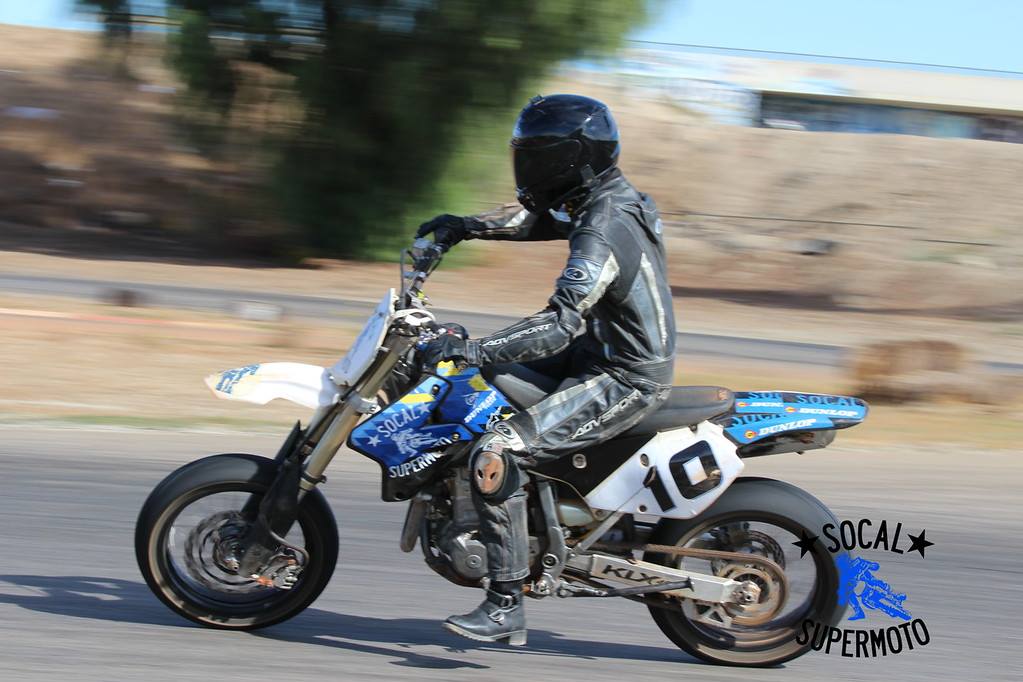
Supermoto positioning is a little weird for me. It’s somewhat more like dirt bike riding, which I haven’t done yet. You’re supposed to scoot your body up on the tank quite a bit further than you do on a street bike, and lean away from the turns instead of into them. These things combined make it more comfortable to pop your foot out toward the inside of the turn – giving you the most ground clearance. I tried to get this position to work for me all morning, but I found it was just making me really tired and I was struggling to hold out my foot. I know for a fact that I was doing something very basic incorrectly with my body – but I’ll have to go back for another round to figure out exactly what that wrong thing is.
Trail Braking
Trail braking is something the MSF course explicitly tells you not to do. In the MSF you should never apply the brakes in a turn. As it turned out, I had taught myself a form of trail braking that is totally contrary to everything supermoto and I use the rear brake in turns but almost never the front. This isn’t a big deal when you’re riding a street bike on the street, but on the slick track it means that the rear tire breaks loose Every Time You Hit The Rear Brake. The first time I did it, I was horrified (but I saved it). The second time I did it, I was less horrified and saved it. The third time I did it I told myself to chill out and stop doing that before I hurt myself by unintentionally losing traction.
Dirt!
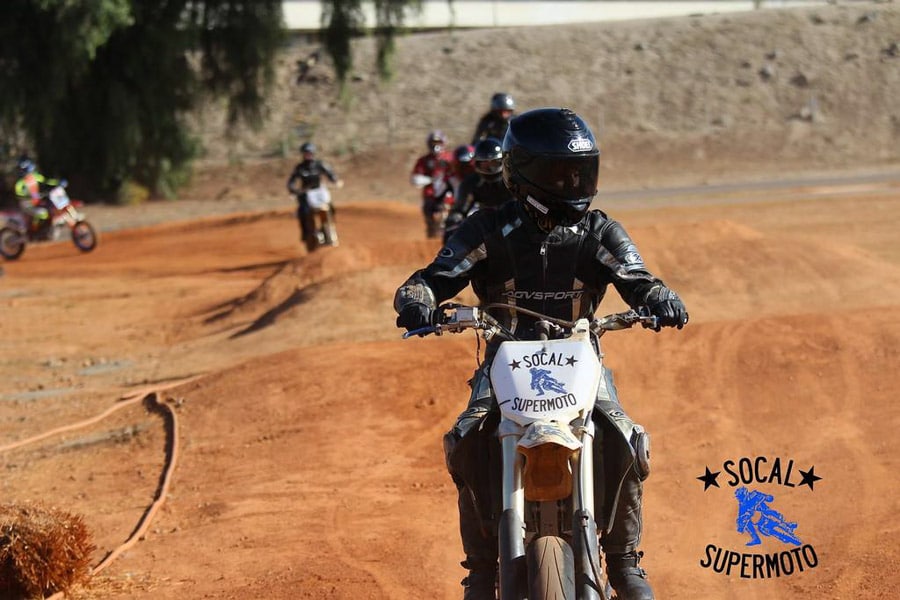
After a quick lunch of pizza (vegans should bring their own lunch, but there were vegetarian options), we got to start all over learning to ride those twitchy little bikes in the dirt.
If you’ve ever taken your street bike on a dirt road for any period of time, you know how mildly horrifying it can be. Street tires have next to no traction in the dirt, and it’s hard to look very far ahead without starting to panic about it. Good news! You’ll get over some of that fear quickly here! Brian gives a few pointers after lunch (don’t use the front brake in the dirt, don’t brake in a turn, and stand up any time you’re going straight), and then sends you off to your fate. It’s pretty typical to see a bunch of riders dump their bikes in the dirt – which is why there’s no crash limit there. Just pick yourself back up and get back at it!
At the end of the day, riders get to participate in a real race with one another. Everyone lines the bikes up on the straightaway, goes across the track, and RUNS to their bikes to start. I’m not even going to pretend that running in sweaty used leathers for like 10 feet on an 80 degree day didn’t suck. It totally sucked. But that’s part of the fun of doing something like this – because it was awesome to ride around that track with all the girls going full out with all their new skills knowing everyone of you was enjoying the same thing.
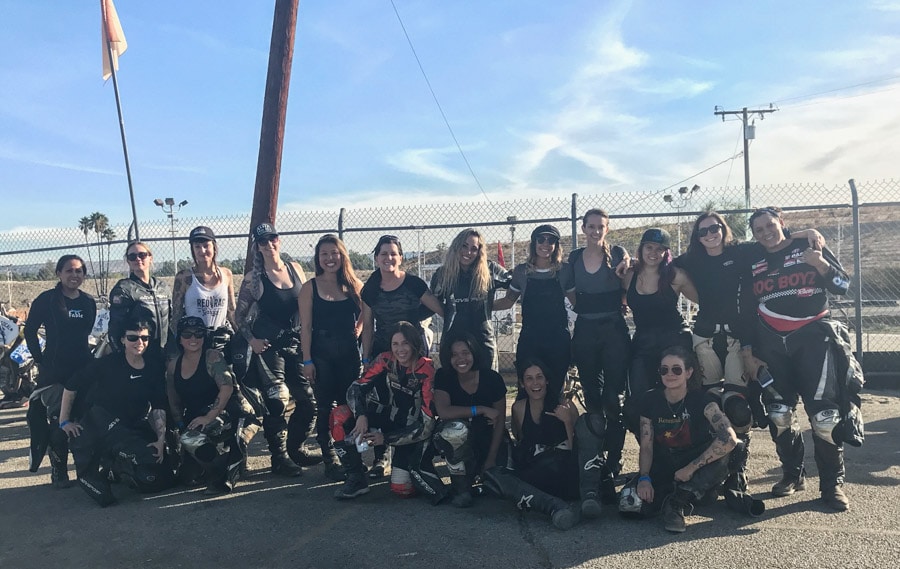
Overall – I loved this class and I want to take it again. I didn’t throw myself into it as much as I usually would have because it ended up being the day before I was leaving for my Death Valley road trip. If I hadn’t been so focused on not hurting myself before a trip, I would have gotten a lot more out of the class – and probably gone down in the dirt.
Sanna however – was less enchanted. She prefers a heavier bike and can’t wait to compare something like this to a more traditional sport bike track day – so I guess we’ll be crossing our fingers for Babes Ride Out to organize one of those in the future!

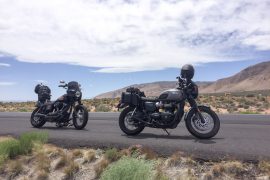
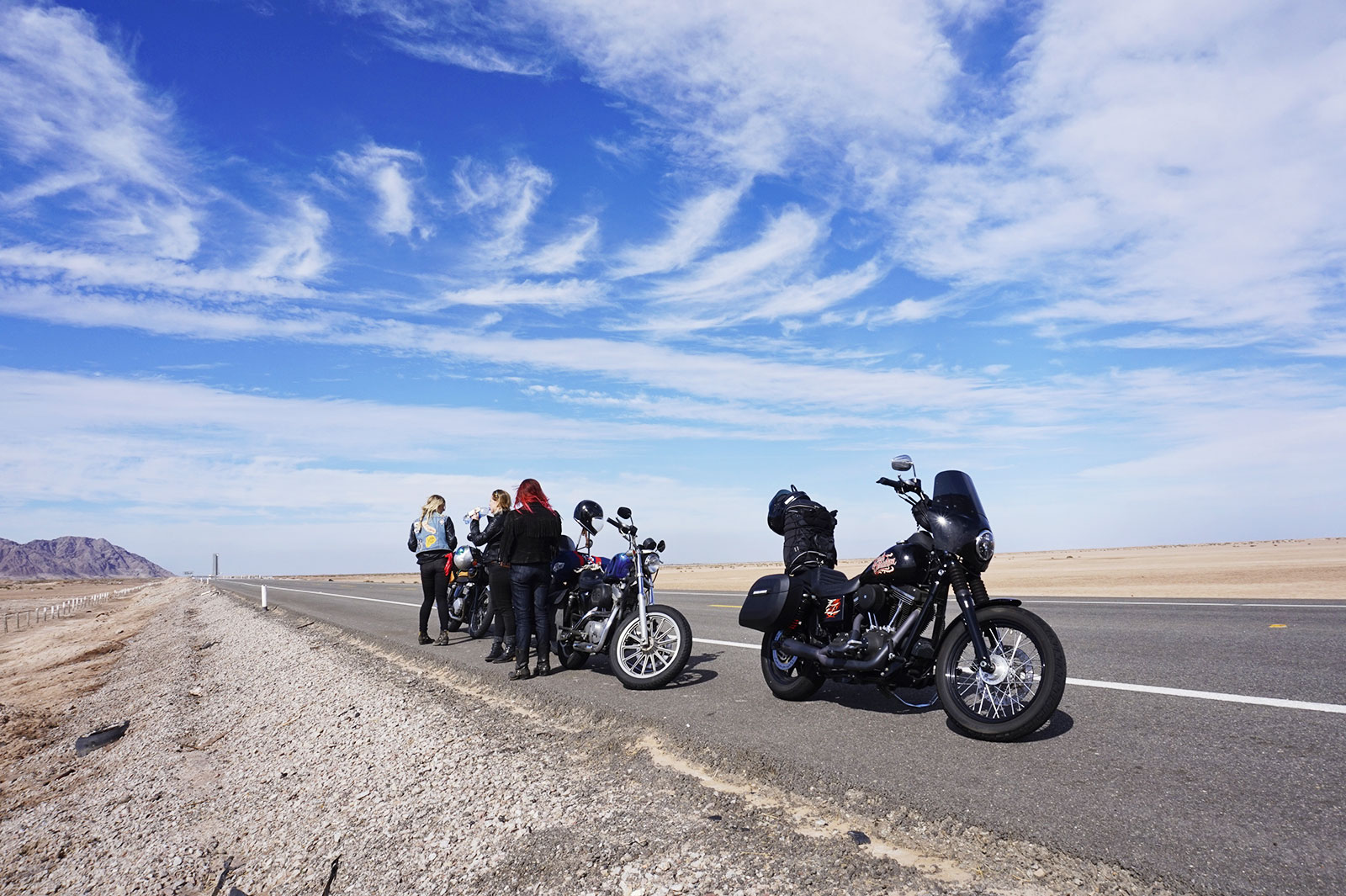

Comments are closed.